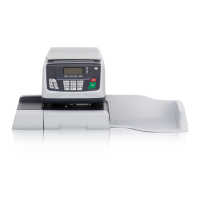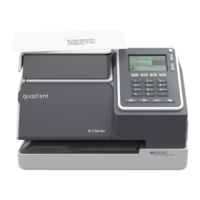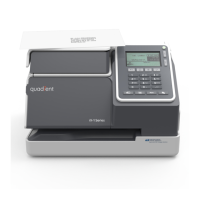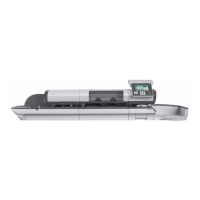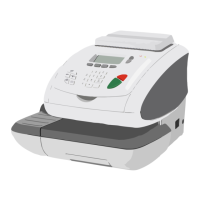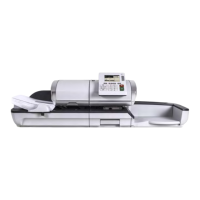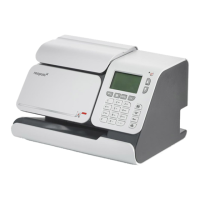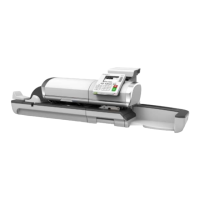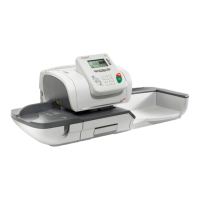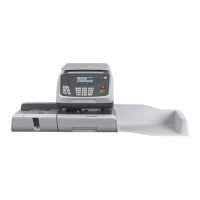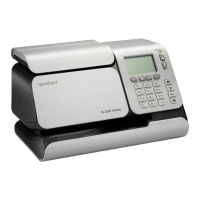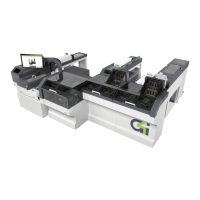Do you have a question about the quadient IX-7 and is the answer not in the manual?
| User Interface | Touchscreen |
|---|---|
| Envelope Capacity | Up to 1, 500 envelopes |
| Connectivity | Ethernet |
| Power Requirements | 220-240V, 50/60Hz |
| Weight | 881.85 lbs (400 kg) |
Covers power connection, grounding, and general safety precautions.
Instructions for immediately stopping the mailing system's operation.
Explanation of manual symbols: warning, attention, notes, and tips.
Defines acronyms and terms used throughout the user guide.
Overview of the mailing system's components and parts.
Details on optional accessories like USB keyboards and report printers.
Explanation of the control panel's display areas, keys, and shortcuts.
Guide to base and dynamic scale connectors for various peripherals.
Information on Energy Star compliance and managing system power modes.
Steps for sorting mail, logging in, and initiating a work session.
Guidance on selecting imprint types for different mail processing needs.
Step-by-step examples for processing various types of mail.
Instructions for setting postage and processing Pre-Paid Imprint mail.
How to use the Payment Surcharge mode for reimbursements.
Procedures for changing accounts, rates, and weighing parameters.
Advanced functions like resetting counters and managing label dispensers.
How to configure imprint elements: date, ERA, slogan, and print offset.
Creating, editing, modifying, and using job memories for preset configurations.
Introduction to the Postal Security Device (PSD) and its function.
How to check PSD credit and add credit to the mailing system.
Procedure for manually connecting the PSD for postal inspection.
Setting up warnings for low credit levels in the mailing system.
Configuring warnings for postage amounts exceeding a preset value.
Creating and managing a PIN code for authorized credit addition.
Viewing credit history and summary reports of postage refill operations.
Tracking postage by account and controlling user access with PIN codes.
Setting up PIN codes for users to protect the system and restrict credit usage.
Understanding and changing account modes like 'No Account' or 'Account with Access Control'.
Summary and steps for creating new accounts, including format and status.
Procedures for displaying, changing, and managing account modes.
Settings for groups and subgroups, including name, status, and folder.
Importing and exporting account lists as CSV files for backup or modification.
Creating and managing operators, including PIN codes and account access.
Generating reports for accounts and operator lists.
Enhancing account management with budget and surcharge features.
How to change the currently active account for charging.
How to select a rate using shortcut lists, rate wizard, or rate history.
Checking rate updates and downloading new postal rate tables.
Steps to generate and select output for reports (screen, printer, USB).
Details on generating Account, Batch Data, Received Batch Data, and Daily Usage reports.
Includes Budget Consumption, Operator Activity, and Machine Activity reports.
Overview of online services features like reporting, rate updates, and remote support.
Information on automatic and manual calls to online services.
Procedures for ping server and test server diagnostic tests.
Details on Ink Management, Rate Protection, and Account level services.
Describes user and supervisor settings available on the mailing system.
Details on user settings, supervisor settings, and the supervisor PIN code.
Adjusting display brightness and changing display language.
How to adjust system time-outs for motor, sleep, and soft off modes.
Setting high-value warnings, low-credit thresholds, and crediting PIN codes.
Configuring default weighing type, auto weight detection, and zeroing the platform.
Setting default imprint parameters like rate, ERA, slogan, and print offset.
Creating, editing, modifying, and deleting job memories for presets.
Setting the default sealing mode (ON or OFF) for the feeder.
Configuring postal/online services connection and LAN parameters.
Checking/adjusting machine time and date, and setting auto date advance.
How to update the system by adding new options or updating software.
How to read and delete messages received from the system or customer service.
Displaying and loading new options like software or postal rates.
Adding, displaying, modifying, deleting, and downloading slogans.
Loading, renaming, deleting, and downloading ERAs for imprints.
Checking rate updates and downloading new postal rate tables.
Displaying, adding, deleting, and setting default PPI numbers.
Information about the ink cartridge, changing, cleaning, and aligning it.
How to fill the sealer bottle and turn the sealer function on/off.
Procedure to calibrate the touchscreen sensitivity for better responsiveness.
Running registration updates and removing the base (meter).
Procedures for clearing mail jams in the base, feeder, or dynamic scale.
Accessing diagnostic data for ping server, sensors, keypad, and IP configuration.
Displaying software, hardware, and machine counter data.
Envelope and label dimensions, thickness, and weight ranges.
Dimensions, weight, and power specifications of the mailing system.
Recommended temperature, humidity, and weighing accuracy conditions.
Details on dynamic scale range, speed, accounts, and operators.
